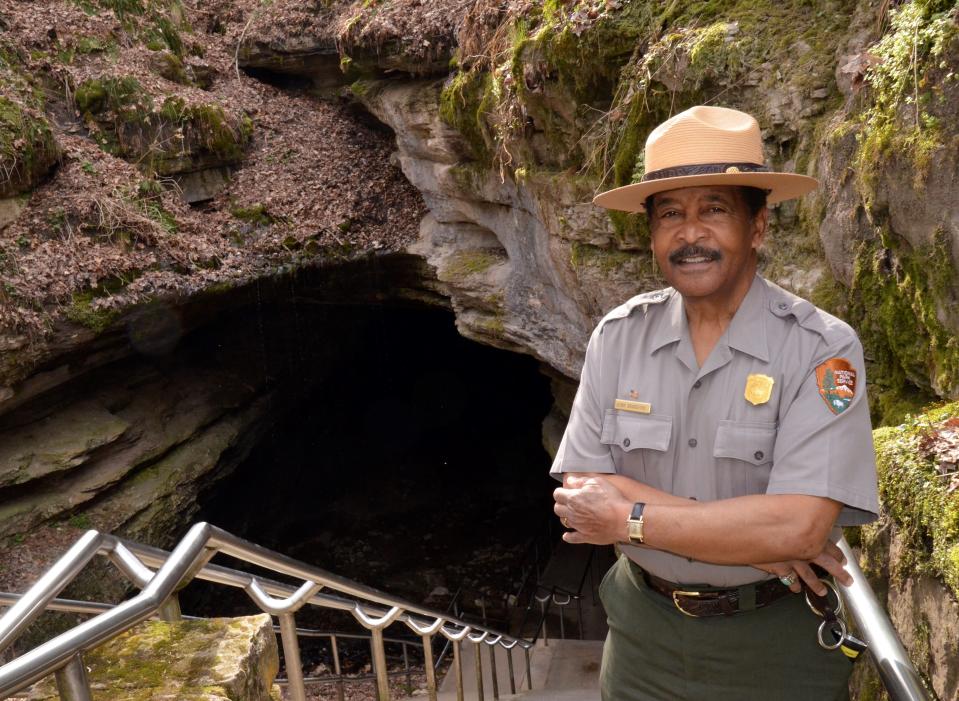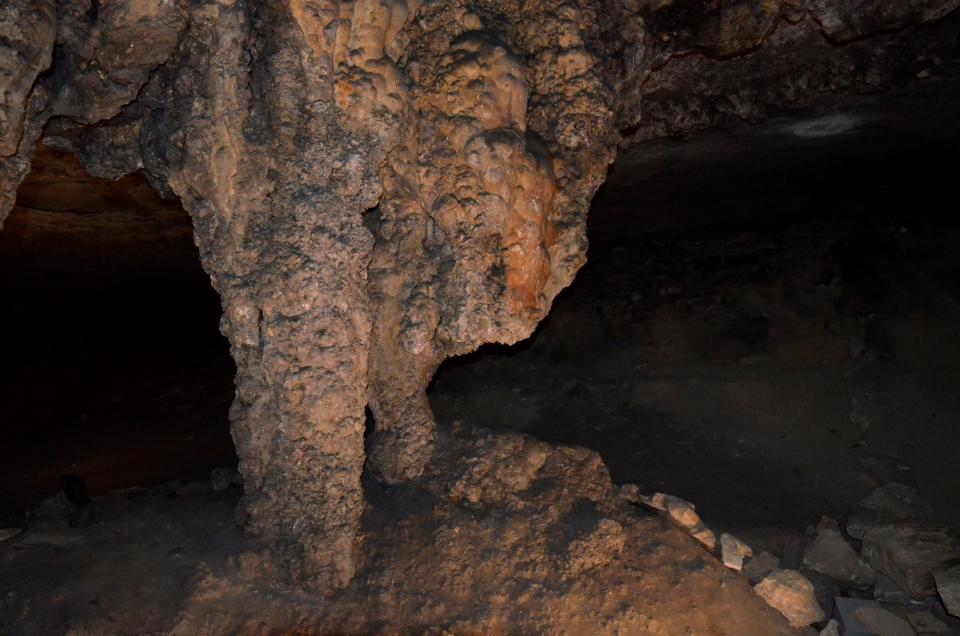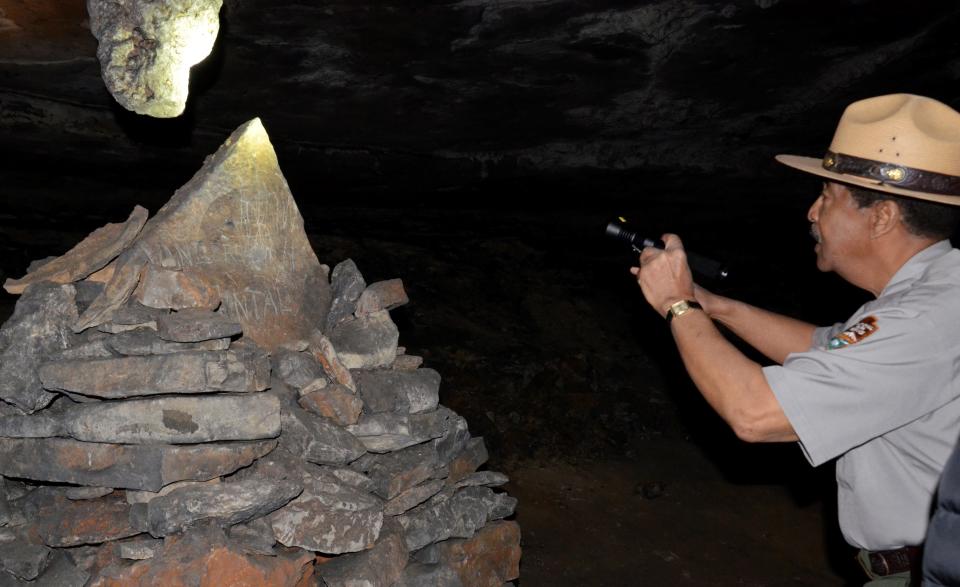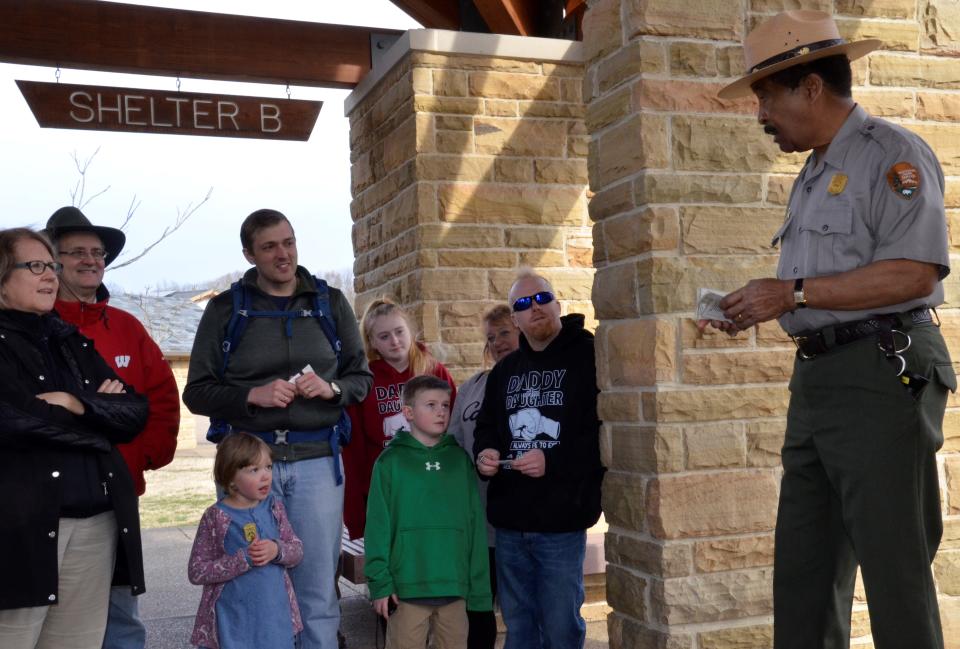His great-great-grandfather was an enslaved guide at Mammoth Cave, now this park ranger hopes to be 'a voice' for his relatives
Two hundred feet below ground level at Mammoth Cave National Park, Park Ranger Jerry Bransford shines his flashlight on the cave's wall and illuminates an inscription: "Mat 1850."
"Mat" was Jerry's great-great-grandfather Materson Bransford, one of three African-American enslaved guides who were the first to introduce tourists to the cave.

Our family lucked into Bransford's two-hour "Historic Tour" coming home from a road trip to Nashville and learned that slaves were key to the early exploration of Mammoth and other nearby caves.
"Sometimes I stand with my feet where Mat's feet were and think about him and how he would have felt on that day," Bransford, 74, said. By 1850, Mat had been conducting cave tours himself for 12 years and was literally leased to the cave's owners.
Established in 1941, Mammoth Cave National Park attracts about a half million visitors a year. Its 52,830-acres preserve the underground cave and some of the beautiful hills in south-central Kentucky's Green River valley.
Mostly limestone, the cave was hollowed out millions of years ago when rainwater formed underground streams.
►'They paved the way': How Buffalo Soldiers shaped America's national parks
►Come explore with us: Subscribe to our Travel newsletter

With 400 miles of discovered passages (and twice that number suspected to exist), Mammoth Cave comprises the world's longest known cave system. It has fantastic rock formations, rare eyeless fish and bacteria under study for the development of new antibiotics. It's a storehouse of natural history, but the social history most captivates Bransford, whose knowledge of his early family history is relatively recent.
After retiring from a 30-year career with Dow Corning Corp. in 2002, he began work for the park as a seasonal guide. "Back then," he said, "through family lore, I only knew back to my grandfather's brother Willie Bransford," another cave guide.
Story continues below.
Connection to Mammoth Cave
The original guide Mat was the grandfather of two brothers, Matterson and Louis. Matterson ran a successful bed and breakfast on land that's now part of the national park. When the government took over the Bransfords' land and business in 1939, they were forced to sell out "cheap," Jerry said.
Louis and his sons, Clifton and Elzie, were also cave guides at the time and also forced out. "They were the last people in my family to turn in their keys and leave," Jerry said.
Jerry Bransford first learned about Mat and earlier relatives from author Joy Medley Lyons, who found Bransford while searching the phone book during research for her 2006 book "Making Their Mark: The Signature of Slavery at Mammoth Cave."
Lately, Bransford, who has worked with other volunteers to restore a neglected cemetery on the national park grounds, has also raised money to build a granite memorial to his relatives and other African American people who are buried there and lived nearby during the 1800s. Bransford hopes to dedicate the memorial in 2022.

Since his retirement, he has also been in contact with a Texas Bransford family descended from Mat's white slaveholders. Slaves often took their white owners' names, and now some of each of the Bransford clans call each other "cousin" even though their joined story began with through enslavement. Three out of four of Mat's children were sold to other white slaveholders, and Mat was inherited as property by his own half-brother after his original owner (and father), Thomas Bransford, died.
Through the generations from 1838 until 1939, dozens of Bransford relatives worked as slaves, and later paid guides, for tourists and luminaries.

Jerry Bransford lived through de-segregation at his high school in Glasgow, Kentucky, served in the army in Germany during the Vietnam War, and remembers returning to Mammoth Cave with his family for picnics during the segregated 1950s.
"The lunchroom was closed to black people, so we had to go to the back door to get Cokes," he said.
This, even after his family had served the park for 100 years. Mat, another Bransford named Nick, and their enslaved friend Stephen Bishop even collaborated to make Mammoth Cave's earliest maps.
Bishop, who was the first to place a plank across the cave's Bottomless Pit, held a lantern in his teeth, wriggled across, and thus opened undiscovered expanses of the cave, which he famously deemed "a grand, gloomy and peculiar place," Bransford said.
His tours are dynamic. During our visit, Bransford stopped to sing a hymn near the spot where a Methodist preacher once gave six-hour sermons to captive audiences. Soot from their torches was still visible a hundred years later.
Tour members also scrunched through the tight passages of an area called Fat Man's Misery and past Bishop's Bottomless Pit, which is actually 105 feet deep, and must have looked terrifying by torchlight.

"I'm here to give a voice to my relatives and the other guides who didn't have an advocate for four generations," he said later. Near the tour's end, Bransford brought our group into a room-sized chamber to demonstrate how utterly dark a place can be, miles underground.
After a nervous minute or two, he flared a match and his candle lit the room.
If you visit Mammoth Cave National Park

Mammoth Cave National Park is about halfway between Louisville, Kentucky, and Nashville, Tennessee. For many road-trippers, it is a convenient stop on the way to southern destinations like Nashville and the Smokies.
Cave tours vary greatly in length, cost, and intensity, but it's easy to find one suited to particular fitness levels and family configurations, said Acting Public Information Officer Jessica Cooper. They range from the $8 self-guided Discovery Tour, about 15 minutes long, to the four-hour Grand Avenue Tour, which is $35 for adults. Two of the most popular tours include the Historic Tour, which our family joined, and the Domes and Dripstones tour.
For more information see the website at or call: 270-758-2180.
Mark Shuman is a freelance writer and an English teacher at McHenry County College.
This article originally appeared on USA TODAY: How slaves, and their families, help shape Mammoth Cave National Park

 Yahoo Movies
Yahoo Movies 
